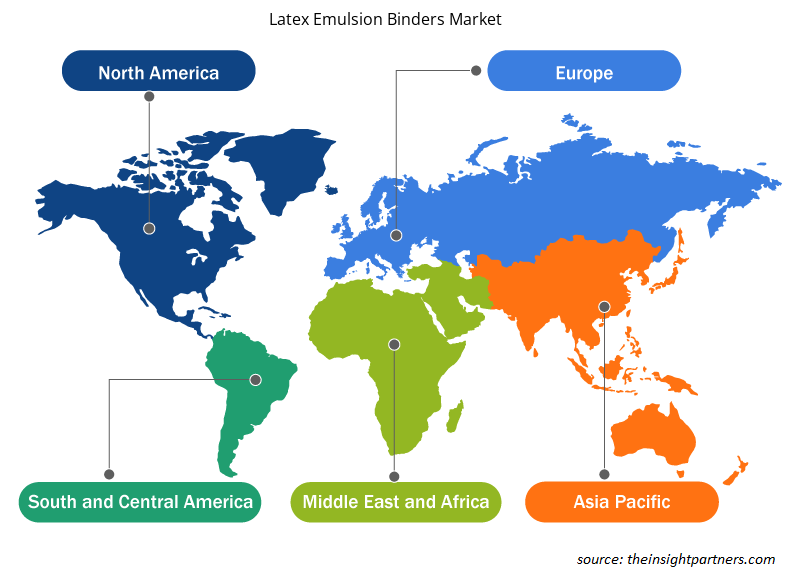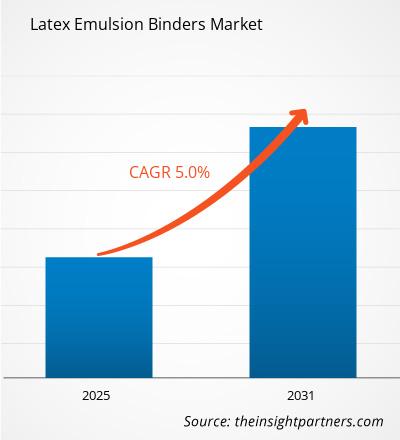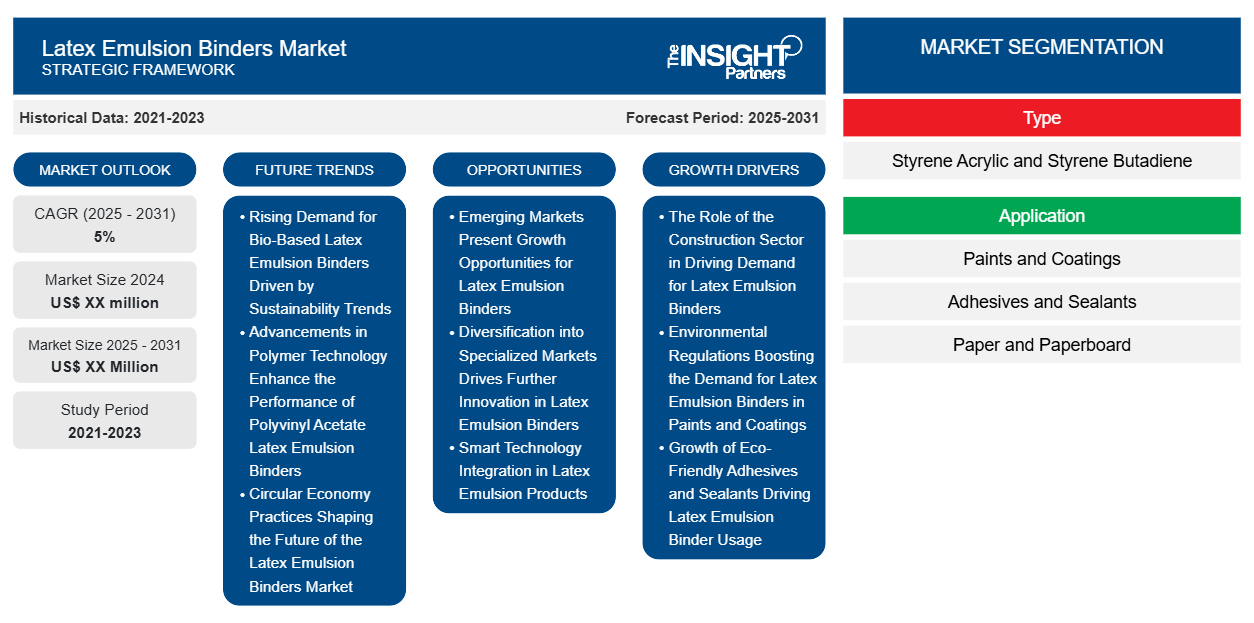乳胶乳液粘合剂市场预计在 2023 年至 2031 年期间的复合年增长率为 5%,市场规模将从 2023 年的 XX 百万美元扩大到 2031 年的 XX 百万美元。
报告按类型(苯乙烯丙烯酸和苯乙烯丁二烯)进行细分。报告进一步根据应用(油漆和涂料、粘合剂和密封剂、纸张和纸板、纺织品、建筑等)进行分析。全球分析进一步细分为区域和主要国家。范围涵盖所有关键细分市场的全球、区域和国家层面的市场规模和预测。报告以美元为单位提供上述分析和细分市场的价值。报告提供了主要市场参与者的市场状况的关键统计数据,并提供了市场趋势和机会。
报告目的
The Insight Partners 撰写的《乳胶乳液粘合剂市场》报告旨在描述当前形势和未来增长、主要驱动因素、挑战和机遇。这将为各种业务利益相关者提供见解,例如:
- 技术提供商/制造商:了解不断变化的市场动态并了解潜在的增长机会,从而能够做出明智的战略决策。
- 投资者:对市场增长率、市场财务预测以及整个价值链中存在的机会进行全面的趋势分析。
- 监管机构:监管市场政策和警察活动,旨在最大限度地减少滥用行为,维护投资者的信任和信心,维护市场的完整性和稳定性。
乳胶乳液粘合剂市场细分
类型
- 苯乙烯丙烯酸酯和苯乙烯丁二烯
应用
- 油漆和涂料
- 粘合剂和密封剂
- 纸和纸板
- 纺织品
- 建筑及其他
定制此报告以满足您的需求
您可以免费定制任何报告,包括本报告的部分内容、国家级分析、Excel 数据包,以及为初创企业和大学提供优惠和折扣
- 获取此报告的关键市场趋势。这个免费样品将包括数据分析,从市场趋势到估计和预测。
乳胶乳液粘合剂市场增长动力
- 建筑业在推动乳胶乳液粘合剂需求方面的作用:建筑业是影响乳胶乳液粘合剂市场增长的主要因素之一。随着城市化和基础设施建设的加快,人们需要先进的建筑材料。乳胶乳液粘合剂因其粘合性能、柔韧性和在不同天气条件下的耐久性而广泛应用于油漆、涂料、粘合剂和密封剂的制造。人们越来越倾向于使用可持续建筑材料,这寻求增加乳胶乳液的供应,因为它们是水基的,挥发性有机成分 (VOC) 含量较低。
- 环境法规推动油漆和涂料中乳胶乳液粘合剂的需求:油漆和涂料行业是乳胶乳液粘合剂市场增长的另一个关键因素。由于环境法规,对乳胶乳液的需求很高,消费者转向水性油漆和涂料。这些粘合剂具有出色的成膜性、耐久性和保色性,可用于内墙和外墙、工业应用和装饰的油漆和涂料。由于绿色和低 VOC 涂料市场持续增长,对乳胶乳液粘合剂的需求也将增长。
- 环保型粘合剂和密封剂的增长推动了乳胶乳液粘合剂的使用:粘合剂和密封剂市场在乳胶乳液粘合剂的增长中也发挥着重要作用。然而,包装、木材和汽车应用对轻质和高端粘合剂的需求不断增长,导致乳胶乳液的使用量增加。这些粘合剂提高了粘合剂的功能性,提供了良好的粘合能力、柔韧性、防潮性和耐化学性。环保包装产品的日益普及推动了对水溶性乳胶基粘合剂的需求,因为它们具有环保设计。
乳胶乳液粘合剂市场未来趋势
- 受可持续发展趋势推动,生物基乳胶乳液粘合剂需求不断增长:作为传统合成粘合剂的替代品,随着制造商寻求推出绿色粘合剂,对生物基乳胶乳液粘合剂的需求正在上升。聚合物化学的进步使得从可再生材料(如植物基聚合物和天然橡胶)开发乳胶乳液成为可能。这些生物基粘合剂的性能与合成粘合剂相似,但对环境的影响较小。然而,这一趋势是为了响应各个市场消费者对可持续产品日益增长的需求,这也有助于市场接受乳胶乳液粘合剂。
- 聚合物技术的进步提高了聚醋酸乙烯酯乳胶乳液粘合剂的性能:由于聚合物技术的最新进步,高性能聚醋酸乙烯酯乳胶乳液粘合剂的生产具有增强的耐腐蚀性能。纳米技术等新发明或聚合工艺的更多进步使得生产出能够更好地粘附、耐用且不受气候影响的乳液成为可能。这些进步使制造商能够生产出满足各种应用需求的乳胶粘合剂,例如汽车涂料的耐热性或建筑产品的防潮性。
- 循环经济实践塑造乳胶乳液粘合剂市场的未来:值得注意的是,循环经济概念正在慢慢渗透到乳胶乳液粘合剂市场。生产商在鼓励注重回收材料和采用更可持续的生产工艺方面更加进步。这包括使产品更具可回收性或在新版本中使用更少的产品,并将消费后废物纳入产品配方中。通过这样做,企业可以控制产生的废物量及其对环境的相关影响,同时满足消费者和立法者对可持续性的要求。
乳胶乳液粘合剂的市场机会
- 新兴市场为乳胶乳液粘合剂带来增长机会:乳胶乳液粘合剂市场的发展前景良好,主要集中在新兴经济体,尤其是亚太、拉丁美洲和非洲地区。这些地区的国家正在经历快速的工业化和城市化,生活水平也不断提高,这导致建筑材料、粘合剂和涂料的使用量不断增加。这是一个机会,可以通过建立本地制造工厂和分销渠道来满足这些经济体对乳胶乳液粘合剂日益增长的需求。
- 多元化进入专业市场推动乳胶乳液粘合剂进一步创新:随着对乳胶乳液粘合剂的兴趣扩展到更专业的领域,创造力和进步的潜力变得更加引人注目。乳胶乳液越来越多地用于汽车、纺织和电子行业,例如高性能涂料和高性能粘合剂。因此,制造商可以通过为这些专业市场提供此类乳胶粘合剂来实现收入多元化并扩大市场基础。
- 乳胶乳液产品中的智能技术集成:将智能技术纳入乳胶产品是创新和发展的绝佳途径。例如,乳胶涂层可能包括无需任何人物理观察即可测量温度和湿度等一系列条件的小工具。此外,可以自行修复损坏的自修复乳胶粘合剂将改变许多行业的游戏规则,包括建筑和汽车。这种向智能材料的转变使制造商能够提供满足客户不断变化的期望的增值产品。
乳胶乳液粘合剂市场区域洞察
Insight Partners 的分析师已详细解释了预测期内影响乳胶乳液粘合剂市场的区域趋势和因素。本节还讨论了乳胶乳液粘合剂市场的各个部分和地理分布,包括北美、欧洲、亚太地区、中东和非洲以及南美和中美洲。

- 获取乳胶乳液粘合剂市场的区域特定数据
乳胶乳液粘合剂市场报告范围
| 报告属性 | 细节 |
|---|---|
| 2023 年的市场规模 | XX 百万美元 |
| 2031 年市场规模 | XX 百万美元 |
| 全球复合年增长率(2023 - 2031) | 5% |
| 史料 | 2021-2022 |
| 预测期 | 2024-2031 |
| 涵盖的领域 | 按类型
|
| 覆盖地区和国家 | 北美
|
| 市场领导者和主要公司简介 |
|
乳胶乳液粘合剂市场参与者密度:了解其对业务动态的影响
乳胶乳液粘合剂市场正在快速增长,这得益于最终用户需求的不断增长,而这些需求又源于消费者偏好的不断变化、技术进步以及对产品优势的认识不断提高等因素。随着需求的增加,企业正在扩大其产品范围,进行创新以满足消费者的需求,并利用新兴趋势,从而进一步推动市场增长。
市场参与者密度是指在特定市场或行业内运营的企业或公司的分布情况。它表明在给定市场空间中,相对于其规模或总市场价值,有多少竞争对手(市场参与者)存在。
在乳胶乳液粘合剂市场运营的主要公司有:
- 盛禧奥
- 巴斯夫
- DIC公司
- 陶氏
- 瓦克化学股份有限公司
免责声明:上面列出的公司没有按照任何特定顺序排列。

- 了解乳胶乳液粘合剂市场的主要参与者概况
主要卖点
- 全面覆盖:报告全面涵盖了乳胶乳液粘合剂市场的产品、服务、类型和最终用户的分析,提供了整体概况。
- 专家分析:报告基于对行业专家和分析师的深入了解而编写。
- 最新信息:该报告涵盖了最新信息和数据趋势,确保了其与业务的相关性。
- 定制选项:此报告可以定制以满足特定客户要求并恰当地适应业务策略。
因此,乳胶乳液粘合剂市场研究报告有助于引领解读和了解行业情景和增长前景。尽管可能存在一些合理的担忧,但本报告的总体优势往往大于劣势。
- 历史分析(2 年)、基准年、预测(7 年)及复合年增长率
- PEST和SWOT分析
- 市场规模、价值/数量 - 全球、区域、国家
- 行业和竞争格局
- Excel 数据集
近期报告
客户评价
购买理由
- 明智的决策
- 了解市场动态
- 竞争分析
- 客户洞察
- 市场预测
- 风险规避
- 战略规划
- 投资论证
- 识别新兴市场
- 优化营销策略
- 提升运营效率
- 顺应监管趋势





















 获取免费样品 - 乳胶乳液粘合剂市场
获取免费样品 - 乳胶乳液粘合剂市场